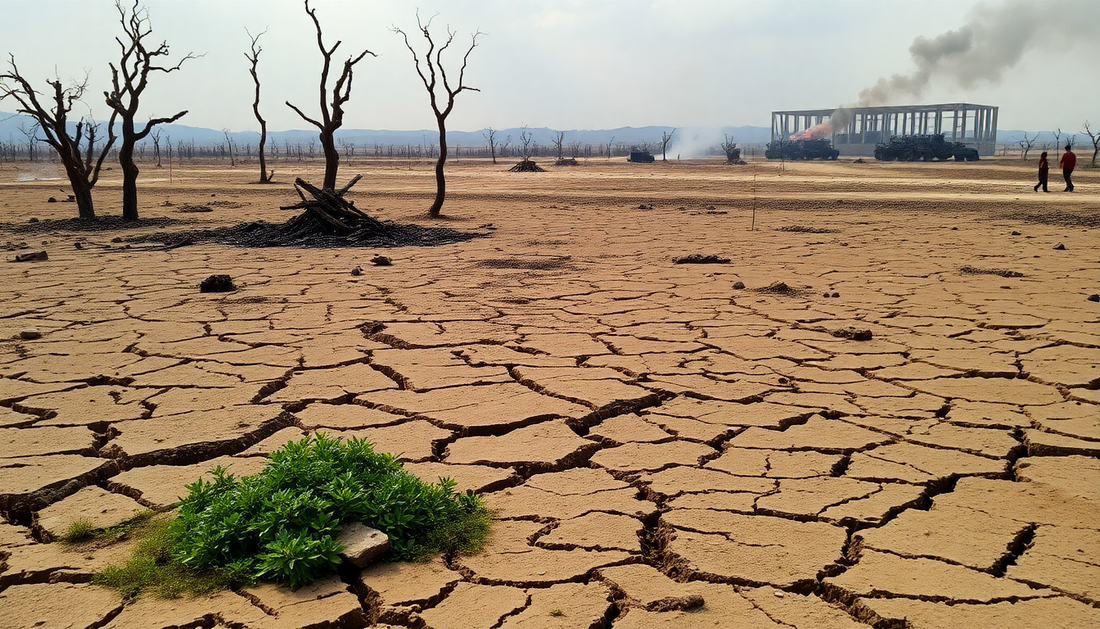The earth's soil, that unassuming foundation upon which our very existence rests, has long been a silent witness to the ravages of war. As nations clash and armies march, the delicate balance of this vital resource is disrupted, leaving behind a legacy of destruction that echoes through the ages. In this comprehensive exploration, we will delve into the profound impact that wars have on the soil, uncovering the mechanisms of its degradation and the far-reaching consequences that reverberate across the globe.
The Unseen Casualties of Conflict
When we think of the aftermath of war, the images that often come to mind are those of crumbling buildings, displaced populations, and the tragic loss of human life. Yet, beneath the surface, another silent casualty emerges – the soil, the very foundation upon which our civilizations are built. The physical, chemical, and ecological disruptions caused by military activities can have devastating and long-lasting effects on this precious resource.
Direct Physical Damage
The sheer scale of modern warfare, with its heavy machinery, artillery bombardments, and expansive military operations, can inflict severe physical damage on the soil. The compaction of the earth by tanks and armored vehicles, the creation of trenches and fortifications, and the detonation of explosives all contribute to the destruction of the soil's delicate structure. This disruption can lead to increased erosion, reduced water infiltration, and the loss of essential nutrients and organic matter.
Chemical Contamination
The use of chemical weapons, the leakage of fuels and lubricants, and the residues of military equipment can all introduce a cocktail of toxic substances into the soil. Heavy metals, such as lead and mercury, as well as persistent organic pollutants, can accumulate in the soil, rendering it inhospitable for plant life and posing a threat to the entire food chain. The long-term effects of this chemical contamination can be devastating, with the soil's fertility and productivity severely compromised.
Disruption of Agricultural Ecosystems
Wars often target agricultural areas, either as a means of denying the enemy access to food or as a tactic of scorched-earth warfare. The destruction of farmland, the displacement of farming communities, and the disruption of irrigation systems can have a profound impact on the soil's ability to support food production. This, in turn, can lead to food insecurity, malnutrition, and the destabilization of local and regional economies.
The Lasting Scars of Conflict
The consequences of war's impact on the soil are not limited to the immediate aftermath of a conflict. The long-term effects can be far-reaching, with repercussions that reverberate through generations and across borders.
Soil Erosion and Fertility Loss
The physical damage and chemical contamination of the soil can lead to a vicious cycle of erosion and fertility loss. As the soil's structure is compromised, it becomes more susceptible to wind and water erosion, further depleting its essential nutrients and organic matter. This, in turn, reduces the soil's ability to support plant growth, leading to a decline in agricultural productivity and the potential for desertification.
Ecosystem Disruption and Biodiversity Loss
The degradation of the soil can have a cascading effect on the entire ecosystem. The loss of plant life and the accumulation of toxic substances can disrupt the delicate balance of the food web, leading to the decline of animal populations and the reduction of biodiversity. This ecological disruption can have far-reaching consequences, impacting the resilience and adaptability of the affected regions.
Intergenerational Impacts
The scars left by war on the soil can persist for decades, if not centuries. The accumulation of heavy metals and persistent organic pollutants can contaminate the soil for generations, posing a continuous threat to human health and the environment. This legacy of soil degradation can also hinder the ability of local communities to rebuild and recover, perpetuating the cycle of instability and environmental degradation.
Confronting the Challenge: Rehabilitation and Recovery
In the face of this daunting challenge, the international community has made strides in developing strategies to address the soil-related consequences of war. These efforts aim to not only repair the immediate damage but also lay the foundation for long-term environmental restoration and sustainable land management.
Soil Remediation Techniques
Advances in soil remediation technologies have provided new tools to address the chemical contamination of the soil. Methods such as phytoremediation, which utilizes plants to extract and break down pollutants, and in-situ stabilization, which immobilizes toxic substances, offer promising solutions for restoring the soil's health.
International Cooperation and Environmental Restoration Efforts
Recognizing the global nature of the problem, various international organizations and initiatives have emerged to coordinate efforts in post-conflict soil rehabilitation. These include programs that provide technical and financial assistance, as well as frameworks for environmental protection during armed conflicts.
Sustainable Land Management Strategies
Alongside remediation efforts, the implementation of sustainable land management practices is crucial for the long-term recovery of war-torn regions. This includes the adoption of regenerative agriculture techniques, the restoration of natural habitats, and the empowerment of local communities to become stewards of their land.
The Path Forward: Integrating Environmental Consciousness into Global Policy
As the world grapples with the ongoing challenges posed by armed conflicts, it is clear that the protection of the soil must be a central consideration in global policy and decision-making. This requires a multifaceted approach that addresses the environmental impact of war at every stage, from prevention to recovery.
Environmental Protection During Warfare
The development of international legal frameworks and military protocols that prioritize environmental protection during armed conflicts is a crucial step. This includes the regulation of the use of certain weapons and the implementation of measures to minimize the damage to soil and other natural resources.
Strengthening Environmental Restoration Efforts
Increased funding, technical support, and international cooperation are essential for scaling up the efforts to rehabilitate war-affected soils. By investing in research, capacity-building, and the dissemination of best practices, the global community can accelerate the recovery of these vital resources.
Fostering Environmental Consciousness in Conflict Zones
Empowering local communities and raising awareness about the importance of soil conservation in conflict-affected regions can help build resilience and foster long-term environmental stewardship. This approach, combined with the integration of traditional ecological knowledge, can contribute to the development of sustainable land management strategies.
Conclusion: Safeguarding the Soil, Securing Our Future
As we grapple with the devastating impact of wars on the soil, it is clear that the preservation of this fundamental resource must be a global priority. By understanding the mechanisms of soil degradation, implementing effective rehabilitation strategies, and integrating environmental consciousness into global policy, we can work towards a future where the scars of war are healed, and the earth's soil can once again thrive, supporting the resilience and prosperity of our shared home.

